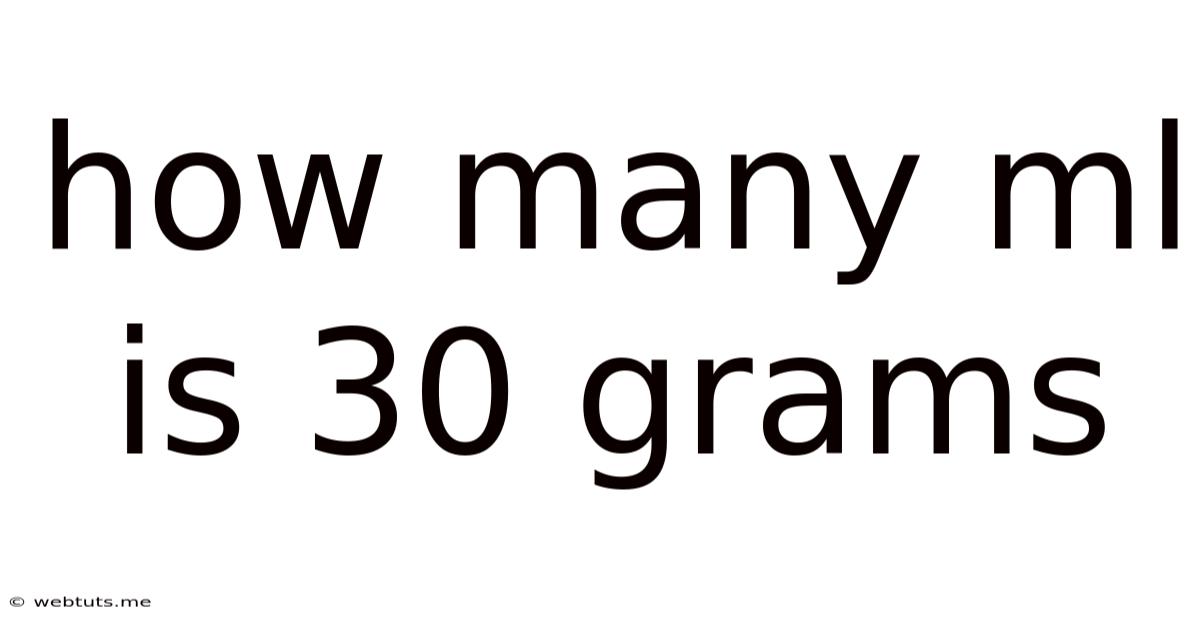How Many Ml Is 30 Grams
Webtuts
Apr 09, 2025 · 4 min read

Table of Contents
Decoding the Mystery: How Many mL is 30 Grams?
The question, "How many mL is 30 grams?" is a common one, particularly for cooks, scientists, and anyone working with both volume and mass measurements. The answer, however, isn't a simple number. It depends entirely on the density of the substance you're measuring. This article will delve into the intricacies of this conversion, providing you with the tools and knowledge to tackle similar conversions confidently.
Understanding the Difference Between Grams and Milliliters
Before diving into the conversion, it's crucial to understand the fundamental difference between grams (g) and milliliters (mL).
-
Grams (g): A unit of mass, representing the amount of matter in an object. Think of it as how much "stuff" is there.
-
Milliliters (mL): A unit of volume, representing the amount of space an object occupies. Think of it as how much space the "stuff" takes up.
The key takeaway here is that mass and volume are not interchangeable. A gram of feathers occupies far more space than a gram of lead, despite having the same mass. This difference is due to density.
The Crucial Role of Density
Density is the key to converting between mass and volume. It's defined as the mass per unit volume of a substance. The formula is:
Density = Mass / Volume
This can be rearranged to solve for volume:
Volume = Mass / Density
To find out how many mL are in 30 grams, we need the density of the substance. Different substances have vastly different densities. For example:
-
Water: At 4°C (39.2°F), the density of water is approximately 1 g/mL. This means 1 gram of water occupies 1 milliliter of space.
-
Oil: The density of oil varies depending on the type, but it's generally less than water, around 0.9 g/mL.
-
Mercury: Mercury is much denser than water, with a density around 13.6 g/mL.
Let's illustrate this with examples:
Example 1: Converting 30 grams of Water to mL
Since the density of water is approximately 1 g/mL, the conversion is straightforward:
Volume = Mass / Density = 30 g / 1 g/mL = 30 mL
Therefore, 30 grams of water is approximately 30 mL.
Example 2: Converting 30 grams of Oil to mL
Let's assume the density of the oil is 0.9 g/mL. The calculation would be:
Volume = Mass / Density = 30 g / 0.9 g/mL ≈ 33.33 mL
Therefore, 30 grams of oil is approximately 33.33 mL.
Example 3: Converting 30 grams of Mercury to mL
Using the density of mercury (13.6 g/mL):
Volume = Mass / Density = 30 g / 13.6 g/mL ≈ 2.21 mL
Therefore, 30 grams of mercury is approximately 2.21 mL.
These examples clearly demonstrate how significantly density influences the volume occupied by a given mass.
How to Find the Density of a Substance
Determining the density is the most challenging part of this conversion. Here are several ways to find the density of a substance:
-
Look it up: Many online resources and chemistry handbooks provide density information for various substances. Searching "[substance name] density" on Google will often yield results. Be sure to note the temperature, as density can change with temperature.
-
Measure it: If you have the substance, you can measure its density experimentally. This involves measuring both the mass and volume of a sample. You can measure mass using a scale and volume using a graduated cylinder or other appropriate measuring device. Then apply the density formula.
-
Use a Density Calculator: Many online calculators can perform this conversion for you, provided you input the mass and the density of the substance.
Practical Applications and Considerations
The ability to convert between grams and milliliters is crucial in many fields:
-
Cooking & Baking: Recipes often use both mass (grams) and volume (milliliters or teaspoons, tablespoons) measurements. Understanding density helps ensure accurate conversions.
-
Science Experiments: Accurate measurements are essential in scientific experiments, and converting between mass and volume is a common task.
-
Medicine: Many medications are administered based on both mass and volume.
-
Manufacturing: In industries involving liquids, accurate conversions between mass and volume are vital for quality control and efficiency.
Common Mistakes to Avoid
-
Assuming all substances have the same density: This is a significant error. Remember, density varies greatly between substances.
-
Not considering temperature: Density can change with temperature. Always specify the temperature when reporting density values.
-
Using inaccurate measuring tools: Using imprecise scales or measuring cylinders will lead to inaccurate results.
Conclusion: The Importance of Precision
Converting 30 grams to milliliters is not a straightforward calculation. It requires knowledge of the substance's density. By understanding the relationship between mass, volume, and density, and by using accurate measuring tools and reliable density data, you can perform these conversions with confidence and precision. Remember to always consider the specific substance you are working with and its unique properties. Accurate conversions are essential for success in various fields, from cooking to scientific research. Mastering this concept will enhance your ability to accurately measure and work with materials in any context.
Latest Posts
Latest Posts
-
How To Calculate 3 Percent Raise
May 09, 2025
-
How Many Hours Is 9 Months
May 09, 2025
-
How Many Days Until Dec 12 2024
May 09, 2025
-
How Many Days Is 31 Weeks
May 09, 2025
-
How To Calculate Your Raise Percentage
May 09, 2025
Related Post
Thank you for visiting our website which covers about How Many Ml Is 30 Grams . We hope the information provided has been useful to you. Feel free to contact us if you have any questions or need further assistance. See you next time and don't miss to bookmark.